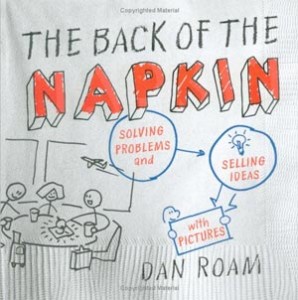Slides vs Back of a Napkin
December 7th, 2008 I just finished reading Dan Roam’s “The Back of the Napkin” a book about solving problems and selling ideas with pictures drawn on the back of a napkin. Dan makes a great case for the power of using visual thinking to solve problems and sell ideas. I agree with almost all of his concepts related to thinking visual can lead to faster and better solutions. It’s a fast read with lots of pictures of course. The back of a napkin and/or white board can be a great tool to assist in the visual thinking process.
I just finished reading Dan Roam’s “The Back of the Napkin” a book about solving problems and selling ideas with pictures drawn on the back of a napkin. Dan makes a great case for the power of using visual thinking to solve problems and sell ideas. I agree with almost all of his concepts related to thinking visual can lead to faster and better solutions. It’s a fast read with lots of pictures of course. The back of a napkin and/or white board can be a great tool to assist in the visual thinking process.
But, I believed the electronic slide (PowerPoint) is a MUCH better business communication tool than the back of a napkin can ever be. Yes, it may take a little longer to learn than drawing with a felt tip marker and white napkin, but it is infinitely more powerful with it’s ability to create fast, effective support visuals. Using the back of a napkin is a great tool for developing visuals of ideas that in the end will be more effectively edited, modified, and finally communicated with a good PowerPoint deck than a few napkins or a drawing on a white board.
Rough sketch drawings play an important role in the development of effective final visuals that support a critical or complex communication message. Using his visual thinking process tools like his “Visual Thinking Toolkit, The SVID, and the <6><6> Rules” will be a big help to anyone developing support visuals.
More important I totally agree that using visual thinking tools often helps develop more than just a good support visual, but very often results in a better understanding of the problem and the best solution.
The process of developing effective visuals on the back of a napkin or a PowerPoint slide can lead to better understanding of the message by the presenter as they work out the details to make the visual clear, simple and easily understood by the audience.
One of the problems with tools like PowerPoint is that it makes it too easy to create something that looks OK and seems to support your message, but all too often just a duplication of numbers and text information that adds no further clarity to your important message. This is compounded by the speed of business today where people throw some information on a slide – think in looks ok, maybe adds a stock image or two and presents with it.
The real power of PowerPoint is when the presenter(s) use the development of the slides and MS PowerPoint application tools as an opportunity to develop their ideas to the point where the ideas are effectively communicated. The other part of the problem is many executives today don’t take the time, or don’t have the time it really takes to develop good support visuals whether on a PowerPoint slide or back of a napkin.
A picture can be worth a thousand words, but it has to be a good picture – whether drawn on a napkin or digital projector screen.
